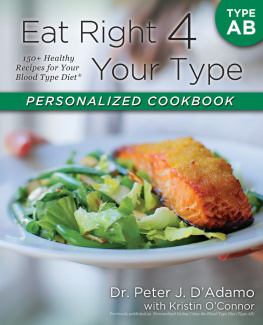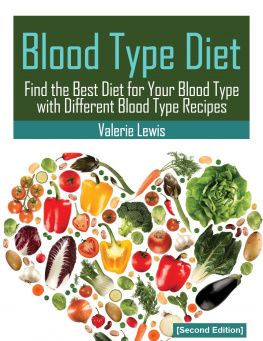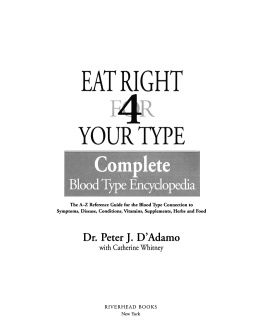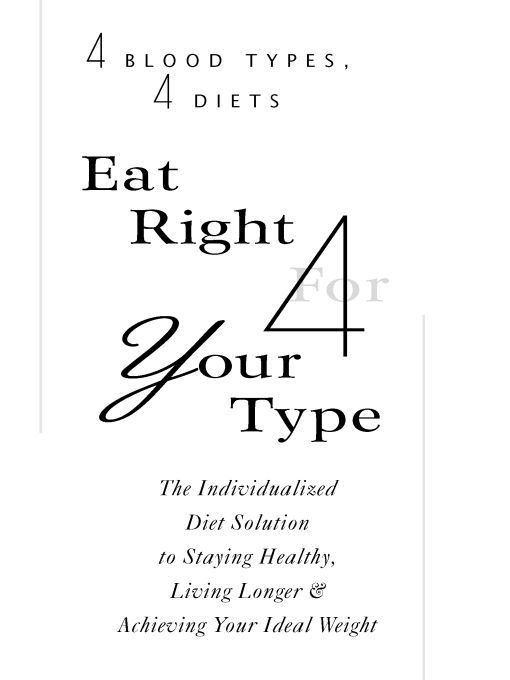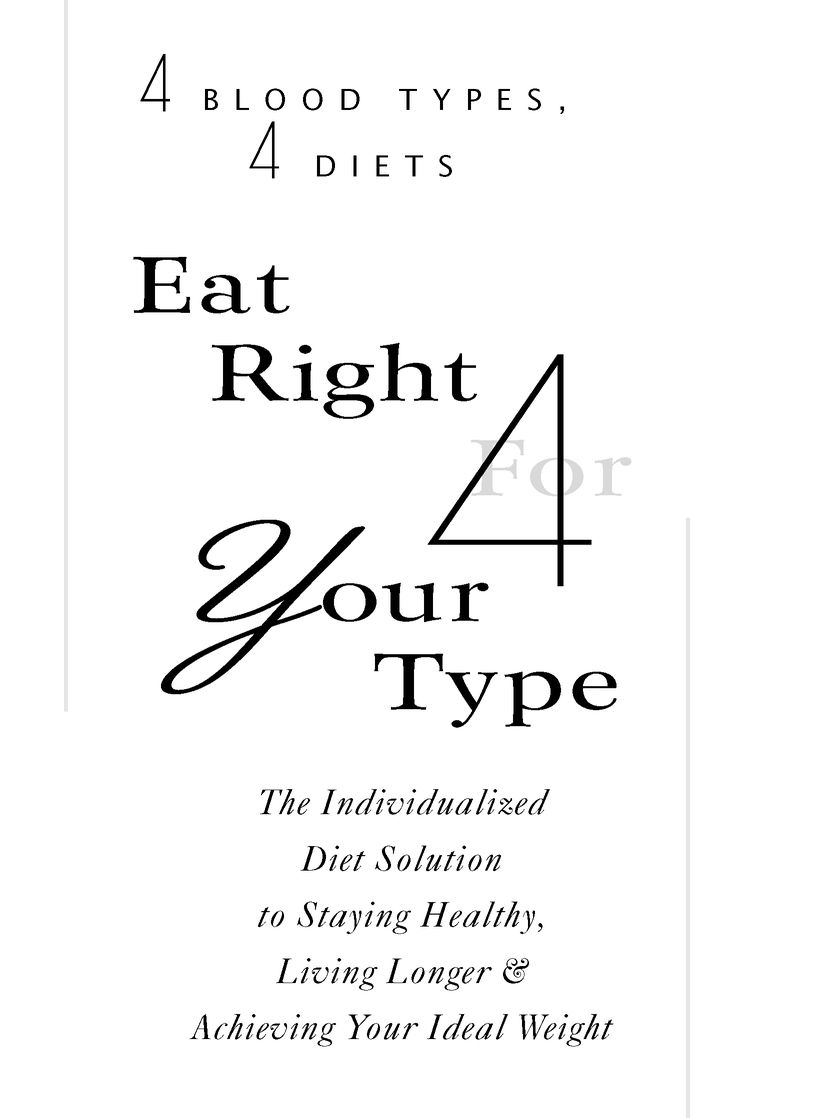Table of Contents
DR. PETER J. DADAMO
WITH CATHERINE WHITNEY
G . P . PUTNAMS SONS
NEW YORK
To the memory of my good friend
JOHN J. MOSKO (1919-1992)
This day is called the feast of Crispian: He that outlives this day, and comes home safe, Will stand a tip-toe when this day is named, And rouse him at the name of Crispian.
Acknowledgments
THERE ARE MANY PEOPLE TO THANK, AS NO SCIENTIFIC pursuit is solitary. Along the way, I have been driven, inspired, and supported by all of the people who placed their confidence in me. In particular, I give deep thanks to my wife, Martha Mosko DAdamo, for her love and friendship; my parents, James DAdamo Sr., N.D., and Christiana, for teaching me to trust in my intuition; and my brother, James DAdamo Jr., for believing in me.
I am also more grateful than I can express to:
Joseph Pizzorno, N.D., for inspiring me to trust in the science of natural medicine;
Catherine Whitney, my writer, who imparted a style and organization to the raw material characteristic of a true wordsmith;
Gail Winston, the editor who long ago, out of the clear blue sky, rang me up and asked me if I wanted to write a book about natural medicine;
My literary agent, Janis Vallely, who saw the promise of my work and didnt allow it to languish somewhere in a dusty file cabinet; Amy Hertz, my editor at Riverhead/Putnam, whose vision turned the manuscript into the rich and important document I believe it has now become.
I am also thankful to:
Dorothy Mosko, for her invaluable assistance in the preparation of the early manuscript;
Scott Carlson, my erstwhile assistant, who never missed a UPS pickup;
Carolyn Knight, R.N., my right-hand nurse and expert phlebotomist;
Jane Dystel, Catherines literary agent, whose advice was always on target;
Paul Krafin, who lent his sharp writing and editing skills to the revision process;
Dina Khader, R.D., who helped with the recipes and meal planning;
Michael Schachter, M.D., Jonathan Wright, M.D., and Alan Dat ner, M.D., for their valuable suggestions and guidance.
John Schuler, who designed the illustrations.
Denise Silvestro, who has continued to shepherd the work at Putnam.
I also wish to thank the research interns at Bastyr University, who expertly sifted through the extensive medical literature pertaining to blood type, helping to make this book as complete an account of the subject as possible.
Lastly, I thank all the wonderful patients, who in their quest for health and happiness chose to honor me with their trust.
AN IMPORTANT NOTE: This book is not intended as a substitute for the medical recommendations of physicians or other healthcare providers. Rather, it is intended to offer information to help the reader cooperate with physicians and health professionals in a mutual quest for optimum well-being.
The identities of people described in the case histories have been changed to protect patient confidentiality.
The publisher and the author are not responsible for any goods and/or services offered or referred to in this book and expressly disclaim all liability in connection with the fulfillment of orders for any such goods and/or services and for any damage, loss, or expense to person or property arising out of or relating to them.
INTRODUCTION
The Work of Two Lives
I believed that no two people on the face of the earth were alike; no two people have the same fingerprints, lip prints, or voice prints. No two blades of grass or snowflakes are alike. Because I felt that all people were different from one another, I did not think it was logical that they should eat the same foods. It became clear to me that since each person was housed in a special body with different strengths, weaknesses, and nutritional requirements, the only way to maintain health or cure illness was to accommodate to that particular patients specific needs.
James DAdamo, my father
YOUR BLOOD TYPE IS THE KEY THAT UNLOCKS THE DOOR to the mysteries of health, disease, longevity, physical vitality, and emotional strength. Your blood type determines your susceptibility to illness, which foods you should eat, and how you should exercise. It is a factor in your energy levels, in the efficiency with which you burn calories, in your emotional response to stress, and perhaps even in your personality.
The connection between blood type and diet may sound radical, but it is not. We have long known that there was a missing link in our comprehension of the process that leads either to the path of wellness or to the dismal trail of disease. There had to be a reason why there were so many paradoxes in dietary studies and disease survival. There also had to be an explanation for why some people were able to lose weight on particular diets, while others were not; why some people retained vitality late in life, while others deteriorated mentally and physically. Blood type analysis has given us a way to explain these paradoxes. And the more we explore the connection, the more valid it becomes.
Blood types are as fundamental as creation itself. In the masterly logic of nature, blood types follow an unbroken trail from the earliest moment of human creation to the present day. They are the signature of our ancient ancestors on the indestructible parchment of history.
Now we have begun to discover how to use the blood type as a cellular fingerprint that unravels many of the major mysteries surrounding our quest for good health. This work is an extension of the recent groundbreaking findings concerning human DNA. Our understanding of blood type takes the science of genetics one step further by stating unequivocally that every human being is utterly unique. There is no right or wrong lifestyle or diet; there are only right or wrong choices to be made based on our individual genetic codes.
How I Found the Missing Blood Type Link
MY WORK in the field of blood type analysis is the fulfillment of a lifetime pursuitnot only my own but also my fathers. I am a second-generation naturopathic physician. Dr. James DAdamo, my father, graduated from naturopathic college (a four-year postgraduate program) in 1957 and later studied in Europe at several of the great spas. He noticed that although many patients did well on strict vegetarian and low-fat diets, which are the hallmarks of spa cuisine, a certain number of patients did not appear to improve, and some did poorly or even worsened. A sensitive man with keen powers of deduction and insight, my father reasoned that there should be some sort of blueprint that he could use to determine differences in the dietary needs of his patients. He rationalized that since blood was the fundamental source of nourishment to the body, perhaps some aspect of the blood could help identify these differences. My father set about testing this theory by blood-typing his patients and observing individualized reactions when they were prescribed different diets.
Through the years and with countless patients, a pattern began to emerge. He noticed that patients who were Type A seemed to do poorly on high-protein diets that included generous portions of meat, but did very well on vegetable proteins such as soy and tofu. Dairy products tended to produce copious amounts of mucous discharge in the sinuses and respiratory passages of Type As. When told to increase their levels of physical activity and exercise, Type As usually felt fatigued and unwell; when they performed lighter forms of exercise, such as yoga, they felt alert and energized.


